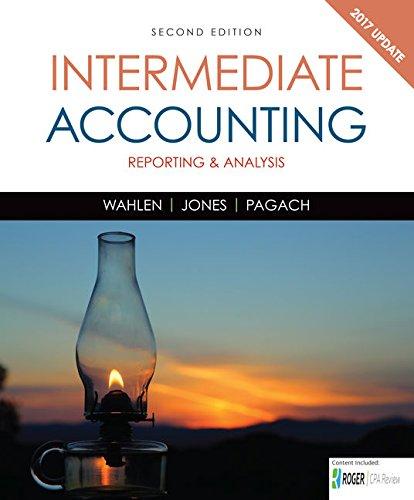
Cengagenowv2, 1 Term Printed Access Card For Wahlen/jones/pagach’s Intermediate Accounting: Reporting And Analysis, 2017 Update, 2nd
2nd Edition
ISBN: 9781337912259
Author: James M. Wahlen, Jefferson P. Jones, Donald Pagach
Publisher: Cengage Learning
expand_more
expand_more
format_list_bulleted
Concept explainers
Question
Chapter 20, Problem 8MC
To determine
Identify the way that lessee records the lease G.
Expert Solution & Answer
Want to see the full answer?
Check out a sample textbook solution
Students have asked these similar questions
General Accounting
Financial Accounting
What is your return for the year on these accounting question?
Chapter 20 Solutions
Cengagenowv2, 1 Term Printed Access Card For Wahlen/jones/pagach’s Intermediate Accounting: Reporting And Analysis, 2017 Update, 2nd
Ch. 20 - Prob. 1GICh. 20 - What is the difference between the lessee and...Ch. 20 - Prob. 3GICh. 20 - Prob. 4GICh. 20 - Prob. 5GICh. 20 - Prob. 6GICh. 20 - What are the two types of lease classifications...Ch. 20 - Prob. 8GICh. 20 - Prob. 9GICh. 20 - Prob. 10GI
Ch. 20 - Prob. 11GICh. 20 - Describe the difference between how a lessee would...Ch. 20 - Prob. 13GICh. 20 - Prob. 14GICh. 20 - Prob. 15GICh. 20 - Prob. 16GICh. 20 - Prob. 17GICh. 20 - Prob. 18GICh. 20 - Prob. 19GICh. 20 - Prob. 20GICh. 20 - Prob. 21GICh. 20 - Prob. 1MCCh. 20 - Prob. 2MCCh. 20 - Prob. 3MCCh. 20 - Prob. 4MCCh. 20 - Prob. 5MCCh. 20 - Prob. 6MCCh. 20 - Prob. 7MCCh. 20 - Prob. 8MCCh. 20 - Rent received in advance by the lessor for an...Ch. 20 - Prob. 10MCCh. 20 - Next Level Keller Corporation (the lessee) entered...Ch. 20 - Prob. 2RECh. 20 - Prob. 3RECh. 20 - Prob. 4RECh. 20 - Prob. 5RECh. 20 - Prob. 6RECh. 20 - Prob. 7RECh. 20 - Prob. 8RECh. 20 - Prob. 9RECh. 20 - Prob. 10RECh. 20 - Prob. 1ECh. 20 - Prob. 2ECh. 20 - Lessee Accounting Issues Sax Company signs a lease...Ch. 20 - Prob. 4ECh. 20 - Prob. 5ECh. 20 - Prob. 6ECh. 20 - Prob. 7ECh. 20 - Lessor Accounting with Receipts at Beginning of...Ch. 20 - Determining Type of Lease and Subsequent...Ch. 20 - Prob. 10ECh. 20 - Prob. 11ECh. 20 - Prob. 12ECh. 20 - Prob. 13ECh. 20 - Prob. 14ECh. 20 - Prob. 15ECh. 20 - Determining Type of Lease and Subsequent...Ch. 20 - Prob. 2PCh. 20 - Prob. 3PCh. 20 - Lessee Accounting Issues Timmer Company signs a...Ch. 20 - Prob. 5PCh. 20 - Prob. 6PCh. 20 - Sales-Type Lease with Receipts at End of Year...Ch. 20 - Prob. 8PCh. 20 - Prob. 9PCh. 20 - Prob. 10PCh. 20 - Prob. 11PCh. 20 - Prob. 12PCh. 20 - Prob. 13PCh. 20 - Prob. 14PCh. 20 - Prob. 15PCh. 20 - Prob. 1CCh. 20 - Prob. 2CCh. 20 - Prob. 3CCh. 20 - Classification of Leases Part a. Capital leases...Ch. 20 - Prob. 5CCh. 20 - Prob. 6CCh. 20 - Prob. 7CCh. 20 - Prob. 8CCh. 20 - Prob. 9CCh. 20 - Prob. 10CCh. 20 - Prob. 11CCh. 20 - Prob. 12CCh. 20 - Prob. 13CCh. 20 - Prob. 14CCh. 20 - Prob. 15C
Knowledge Booster
Learn more about
Need a deep-dive on the concept behind this application? Look no further. Learn more about this topic, accounting and related others by exploring similar questions and additional content below.Similar questions
arrow_back_ios
SEE MORE QUESTIONS
arrow_forward_ios
Recommended textbooks for you
 Intermediate Accounting: Reporting And AnalysisAccountingISBN:9781337788281Author:James M. Wahlen, Jefferson P. Jones, Donald PagachPublisher:Cengage Learning
Intermediate Accounting: Reporting And AnalysisAccountingISBN:9781337788281Author:James M. Wahlen, Jefferson P. Jones, Donald PagachPublisher:Cengage Learning

Intermediate Accounting: Reporting And Analysis
Accounting
ISBN:9781337788281
Author:James M. Wahlen, Jefferson P. Jones, Donald Pagach
Publisher:Cengage Learning
Accounting for Finance and Operating Leases | U.S. GAAP CPA Exams; Author: Maxwell CPA Review;https://www.youtube.com/watch?v=iMSaxzIqH9s;License: Standard Youtube License